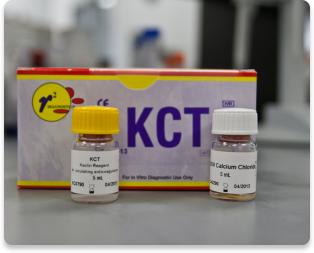LupoTek KCT
Assay Type
Description
Intended Use
Uses

Ordering Information
| Catalog # | Product | Kit Configuration | Regulatory Classification | Product Insert (PDF) |
|---|---|---|---|---|
| 87-305 | LupoTek KCT | 5 x 5 mL | 510(k), CE | LL-4526_H KCT |
Principle of the Test
The Kaolin Clotting Time (PTTK), an activated partial thromboplastin time test which uses kaolin as the activator, was first described in 1958. The Kaolin Clotting Time formulated without any added phospholipid (KCT) was first used to study lupus anticoagulants in 1978, and has been reported to be the most sensitive test for the detection of circulating anticoagulants such as Lupus anticoagulants. In the absence of added phospholipid the assay only poorly accelerates the clotting cascade and is sensitive to coagulopathies in the contact and common pathways.
The KCT is performed as would an APTT. One volume of patient sample is mixed with one volume of the KCT reagent, the mixture incubated for 3 to 5 minutes, and the reaction initiated with the addition of one volume of 25 mM calcium chloride.
An abnormal KCT time is only generally indicative of a defect in coagulability of the neat sample. Mixing tests are recommended for use with the LupoTek KCT reagent in order to distinguish between factor deficiencies and antibody related inhibitors in samples testing outside the normal range. We recommend the 1:1 mix of patient plasma and normal pooled plasma for most testing purposes.
Reporting Units
Handbooks and Guidelines
- Van Cott E and Eby C, Chapter 22, “Antiphospholipid Antibodies”, in An Algorithmic Approach to Hemostasis Testing, KottkeMarchant ed., CAP Press, 2008
- Greaves M, Chapter 16 “Evaluation of Antiphospholipid Antibodies”, in Quality in Laboratory Hemostasis and Thrombosis, Kitchen, Olson, and Preston ed., Wiley-Blackwell, 2009.
- Brandt JT et al, “Criteria for the diagnosis of lupus anticoagulants, an update: on behalf of the Subcommittee on Lupus Anticoagulants/Antiphospholipid Antibodies of the ISTH”, Thrombosis and Hemostasis 74:1597, 1995.
- Pengo V, et al, “Update of the guidelines for lupus anticoagulant detection”, Journal of Thrombosis and Hemostasis 7:1737, 2009.
- Clinical Laboratory Standards Institute, “Laboratory Testing for the Lupus Anticoagulant; Proposed Guideline“, under development.
- Rosner E, et al, “Detection and Quantitative Evaluation of Lupus Circulating Anticoagulant Activity”, Thrombosis and Haemostasis 57:144, 1987.
